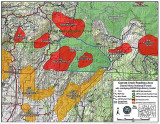
The shadow of a solitary man holding a wooden bow casts across a panel of sunlight. All is silent—except for soft footsteps on a pine needle floor. The hunter pursues his quarry with no advantage but the weapon in hand and a lifetime of woodsmanship.
This is the romanticized image that many modern day sportsmen have of the Native American hunters that preceded us across North America. Antithetical to that, in the minds of some, are the modern hunting trends focused on management and manipulation of landscapes to improve hunting. Words like food plots, timber management, and prescribed fire inspire scorn from these purists and a lust for “the way it used to be.”
But what if this romantic ideal is not entirely true? What if it was Native Americans, not modern day hunters, who first manipulated and managed the American landscape for better hunting? What if Native Americans were the original wildlife habitat managers?
A Wilderness or a Garden?
Many today imagine America, pre-European contact, as an Edenic wilderness untrammeled by man or his impacts. But historians and anthropologists alike call this a fallacy. Charles C. Mann, author of “1491,” explains that, “the Americas in 1491 were not a wilderness. They were a huge, special garden, planned and maintained by the active efforts of a wildly diverse range of societies.”
It was a garden that was planned, cared for, and managed by Native Americans. When Europeans arrived on the shores of America and pushed westward, they came across a procession of landscapes managed by the native peoples—most notably with fire.
“The first white settlers in Ohio found forests as open as English parks—they could drive carriages through the woods,” Mann wrote. “Along the Hudson River the annual fall burning lit up the banks for miles on end; so flashy was the show that the Dutch in New Amsterdam boated upriver to goggle at the blaze like children at fireworks.”
Shepard Krech, in his book “The Ecological Indian,” described the first sight many early Europeans saw of America as “thick clouds of hazy smoke enveloping the land, grasslands reduced to charred stubble, and park-like forests clear of undergrowth.”
Far-reaching grasslands, vast oak savannahs, soaring woodlands open at eye level as far as the eye could see—all of which had been created and stewarded through the use of fire by local tribes.
Why?
The management of local landscapes by Native American tribes was primarily meant to improve their hunting success. “Rather than domesticating animals for meat, Indians retooled whole ecosystems to grow bumper crops of elk, deer, and bison,” Mann wrote.
The most common tool for doing this was fire, which provides multiple benefits to local wildlife. Fire removes low growing brush and thatch, prevents the succession of grasslands into woodlands, restores nutrients to the soil, and even improves diversity of species upon regrowth. The end result, across many parts of America, was an abundance of openings flush with fresh green growth and plenty of sunlight; a recipe then as it still is now, for exceptional wildlife browse.
“I believe Native Americans were excellent vegetation managers,” wrote Marc Abrams, professor of forest ecology and physiology in the College of Agricultural Sciences at Penn State University. “Native Americans knew that to regenerate plant species that they wanted for food, and to feed game animals they relied on, they needed to burn the forest understory regularly.”
How?
The key to Native American success with land management by fire is the same that’s proffered by many in the wildlife management realm today. Strategically located improvements, or in this case, properly timed, low intensity fire.
“The majority of aboriginal fires were set in the spring, between snowmelt and vegetation greenup, or late in the fall when burning conditions were not severe,” Charles E. Kay wrote.
These burns, in many cases, were repeated frequently, every few years or so, to maintain the desired landscape and plant life diversity.
Another example of this strategic approach is found in the efforts of Native Americans along the West Coast, who employed carefully timed fires to benefit deer in chaparral ecosystems.
“Most burns took place in the fall and favored the growth of species browsed by deer in the spring, which was a difficult season for subsistence,” Krech wrote in “The Ecological Indian.” “Indians lit some spring fires, evidently to reduce brushiness and induce sprouting species.”
Native Americans lit these fires in locations that would be most beneficial to them in the future. What was done then is similar to what’s done now by habitat managers—whether with fire, food plots, or timber management. They improved certain landscapes in important areas to increase the presence of wildlife and make them more easily hunted.
Stewardship
It’s tempting to lust for a time when nature was yet unmolested by Homo sapiens. But the wild lands of this planet came of age over tens of thousands of years not outside the influence of man—but alongside it.
Romantic notions aside, it’s clear that the native peoples of America fostered a relationship with their landscape that is worthy of our aspirations. They embraced the idea of land stewardship long before we ever thought of it.
Feature image via Matt Hansen.




